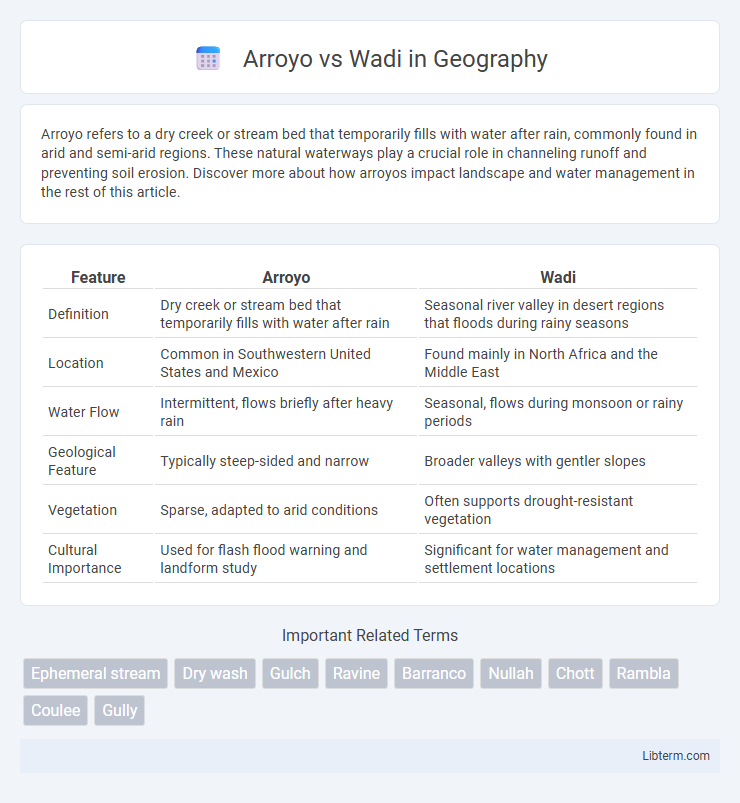Arroyo refers to a dry creek or stream bed that temporarily fills with water after rain, commonly found in arid and semi-arid regions. These natural waterways play a crucial role in channeling runoff and preventing soil erosion. Discover more about how arroyos impact landscape and water management in the rest of this article.
Table of Comparison
| Feature | Arroyo | Wadi |
|---|---|---|
| Definition | Dry creek or stream bed that temporarily fills with water after rain | Seasonal river valley in desert regions that floods during rainy seasons |
| Location | Common in Southwestern United States and Mexico | Found mainly in North Africa and the Middle East |
| Water Flow | Intermittent, flows briefly after heavy rain | Seasonal, flows during monsoon or rainy periods |
| Geological Feature | Typically steep-sided and narrow | Broader valleys with gentler slopes |
| Vegetation | Sparse, adapted to arid conditions | Often supports drought-resistant vegetation |
| Cultural Importance | Used for flash flood warning and landform study | Significant for water management and settlement locations |
Defining Arroyo and Wadi
An arroyo is a dry creek or stream bed that temporarily fills with water after heavy rains, commonly found in arid or semi-arid regions of the southwestern United States and Mexico. A wadi is a similar geographic feature in Arab countries and North Africa, referring to a valley, ravine, or channel that remains dry except during seasonal rains. Both arroyos and wadis serve as critical channels for flash floods, shaping the landscape and influencing local ecosystems.
Etymology and Origin of Terms
Arroyo originates from the Spanish word meaning "brook" or "stream," reflecting its use in the Southwestern United States and Latin America to describe a dry creek or seasonal stream. Wadi derives from the Arabic term "wadi," commonly used in North Africa and the Middle East to denote a valley or dry riverbed that temporarily fills with water during rains. Both terms emphasize natural water pathways shaped by regional linguistic and cultural influences, highlighting their geographical and etymological roots.
Geological Formation Processes
Arroyos and wadis form through the erosion and sediment transport caused by intermittent water flow in arid and semi-arid regions. Arroyos are typically steep-sided channels carved by flash floods, characterized by rapid water movement that scours bedrock and deposits sediments downstream. Wadis, commonly found in desert environments, develop as dry riverbeds during prolonged dry periods, shaped by episodic rainfall that triggers surface runoff and sediment redistribution.
Geographic Distribution and Locations
Arroyos are dry creek beds commonly found in the southwestern United States and northern Mexico, particularly in arid and semi-arid regions such as Arizona, New Mexico, and Texas. Wadis are similar dry riverbeds but are primarily located in North Africa, the Middle East, and parts of South Asia, with notable presence in countries like Egypt, Saudi Arabia, and Pakistan. Both arroyos and wadis serve as natural drainage channels that flood during rare but intense rainfall events in desert and semi-desert landscapes.
Climatic Influences on Arroyos and Wadis
Arroyos and wadis are dry riverbeds that experience intermittent water flow primarily influenced by regional climate patterns. Arroyos, common in arid and semi-arid climates of the American Southwest, often form due to intense, short-duration rainfall leading to flash floods. Wadis, prevalent in Middle Eastern and North African desert climates, reflect seasonal precipitation patterns where sporadic heavy rains create rapid but temporary watercourses across arid landscapes.
Differences in Hydrology and Flow Patterns
Arroyo and wadi differ primarily in their hydrology and flow patterns, with arroyos typically found in the southwestern United States and exhibiting ephemeral flow triggered by intense, short-lived rainfall events. Wadis, common in the Middle East and North Africa, often display more intermittent flow influenced by seasonal precipitation and can sustain longer periods of runoff. The sediment transport and channel morphology in arroyos tend to reflect rapid erosion and deposition during flash floods, whereas wadis may accumulate more alluvial deposits due to their varied flow duration.
Ecological Roles and Biodiversity
Arroyos and wadis serve as critical ecological habitats in arid and semi-arid regions, supporting diverse plant and animal species adapted to intermittent water flow. These dry riverbeds function as vital corridors for nutrient cycling and groundwater recharge, fostering microhabitats with unique biodiversity hotspots. Their episodic water availability enables specialized flora and fauna to thrive, contributing significantly to regional ecological resilience and species diversity.
Human Interaction and Cultural Significance
Arroyos and wadis are dry riverbeds that become active during rainfall, shaping human settlements and agricultural practices in arid regions. In Southwestern United States, arroyos serve as critical water management features, influencing traditional farming and grazing activities, while in the Middle East and North Africa, wadis hold cultural and historical significance as ancient trade routes and sites for seasonal festivals. Communities surrounding these landforms adapt their lifestyles and rituals to the cyclic nature of water flow, reflecting a deep connection between human interaction and environmental conditions.
Similarities and Shared Characteristics
Arroyo and wadi both refer to dry riverbeds that experience intermittent water flow, primarily in arid or semi-arid regions. Both features typically remain dry except during periods of heavy rainfall, serving as natural channels for stormwater runoff and reducing erosion by directing water flow. These landforms support unique ecosystems adapted to sporadic water availability and play crucial roles in groundwater recharge and flood management.
Environmental Challenges and Conservation
Arroyos and wadis, both intermittent watercourses typical of arid regions, face significant environmental challenges including soil erosion, flash flooding, and habitat degradation due to erratic rainfall patterns and human activities like urban development. Conservation efforts focus on restoring natural vegetation, implementing erosion control measures, and promoting sustainable water management to preserve biodiversity and reduce flood risks. Effective monitoring and community engagement are critical to maintaining the ecological functions and resilience of these fragile dryland ecosystems.
Arroyo Infographic

 libterm.com
libterm.com